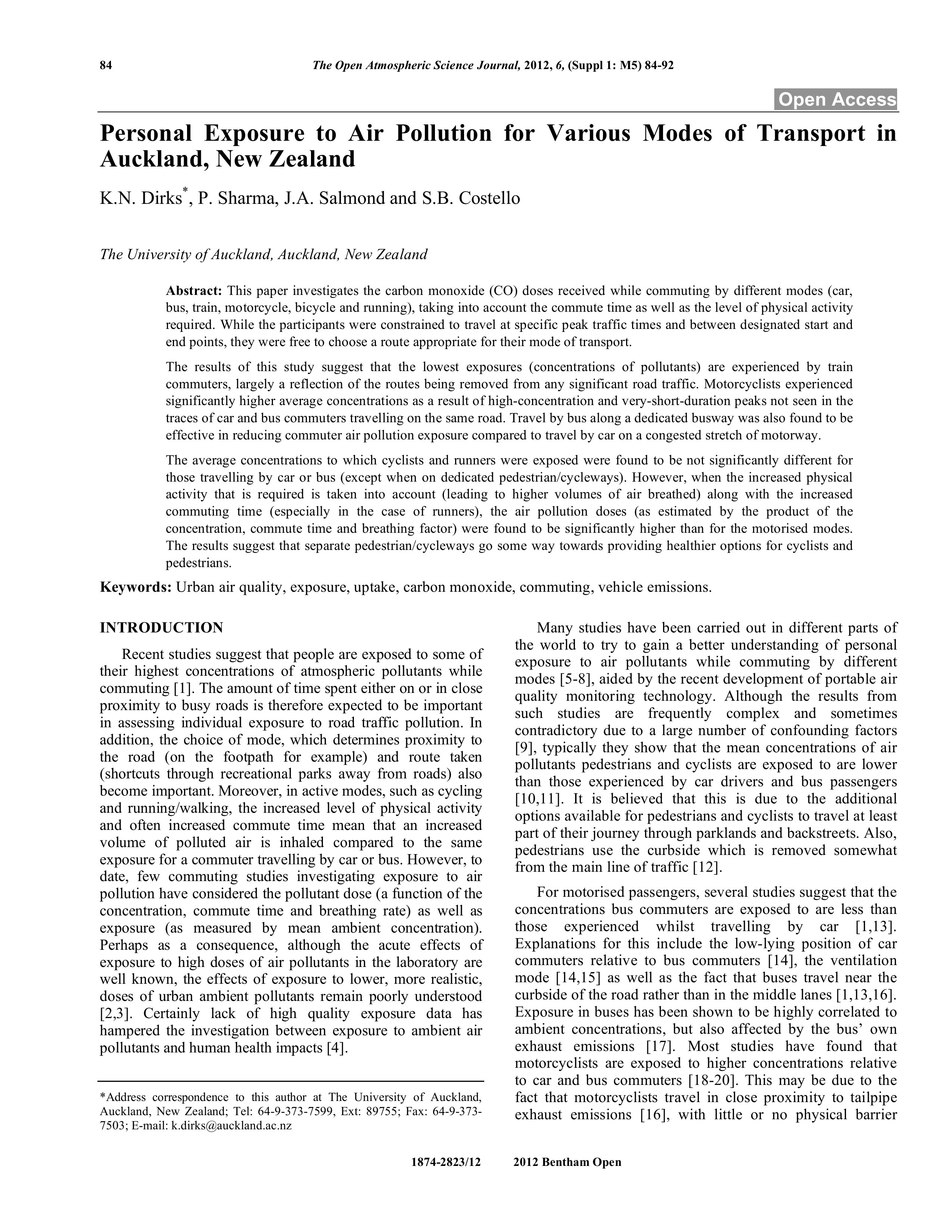Thư viện tri thức trực tuyến
Kho tài liệu với 50,000+ tài liệu học thuật
© 2023 Siêu thị PDF - Kho tài liệu học thuật hàng đầu Việt Nam

Tài liệu Personal Exposure to Air Pollution for Various Modes of Transport in Auckland, New Zealand
Nội dung xem thử
Mô tả chi tiết
84 The Open Atmospheric Science Journal, 2012, 6, (Suppl 1: M5) 84-92
1874-2823/12 2012 Bentham Open
Open Access
Personal Exposure to Air Pollution for Various Modes of Transport in
Auckland, New Zealand
K.N. Dirks*
, P. Sharma, J.A. Salmond and S.B. Costello
The University of Auckland, Auckland, New Zealand
Abstract: This paper investigates the carbon monoxide (CO) doses received while commuting by different modes (car,
bus, train, motorcycle, bicycle and running), taking into account the commute time as well as the level of physical activity
required. While the participants were constrained to travel at specific peak traffic times and between designated start and
end points, they were free to choose a route appropriate for their mode of transport.
The results of this study suggest that the lowest exposures (concentrations of pollutants) are experienced by train
commuters, largely a reflection of the routes being removed from any significant road traffic. Motorcyclists experienced
significantly higher average concentrations as a result of high-concentration and very-short-duration peaks not seen in the
traces of car and bus commuters travelling on the same road. Travel by bus along a dedicated busway was also found to be
effective in reducing commuter air pollution exposure compared to travel by car on a congested stretch of motorway.
The average concentrations to which cyclists and runners were exposed were found to be not significantly different for
those travelling by car or bus (except when on dedicated pedestrian/cycleways). However, when the increased physical
activity that is required is taken into account (leading to higher volumes of air breathed) along with the increased
commuting time (especially in the case of runners), the air pollution doses (as estimated by the product of the
concentration, commute time and breathing factor) were found to be significantly higher than for the motorised modes.
The results suggest that separate pedestrian/cycleways go some way towards providing healthier options for cyclists and
pedestrians.
Keywords: Urban air quality, exposure, uptake, carbon monoxide, commuting, vehicle emissions.
INTRODUCTION
Recent studies suggest that people are exposed to some of
their highest concentrations of atmospheric pollutants while
commuting [1]. The amount of time spent either on or in close
proximity to busy roads is therefore expected to be important
in assessing individual exposure to road traffic pollution. In
addition, the choice of mode, which determines proximity to
the road (on the footpath for example) and route taken
(shortcuts through recreational parks away from roads) also
become important. Moreover, in active modes, such as cycling
and running/walking, the increased level of physical activity
and often increased commute time mean that an increased
volume of polluted air is inhaled compared to the same
exposure for a commuter travelling by car or bus. However, to
date, few commuting studies investigating exposure to air
pollution have considered the pollutant dose (a function of the
concentration, commute time and breathing rate) as well as
exposure (as measured by mean ambient concentration).
Perhaps as a consequence, although the acute effects of
exposure to high doses of air pollutants in the laboratory are
well known, the effects of exposure to lower, more realistic,
doses of urban ambient pollutants remain poorly understood
[2,3]. Certainly lack of high quality exposure data has
hampered the investigation between exposure to ambient air
pollutants and human health impacts [4].
*Address correspondence to this author at The University of Auckland,
Auckland, New Zealand; Tel: 64-9-373-7599, Ext: 89755; Fax: 64-9-373-
7503; E-mail: [email protected]
Many studies have been carried out in different parts of
the world to try to gain a better understanding of personal
exposure to air pollutants while commuting by different
modes [5-8], aided by the recent development of portable air
quality monitoring technology. Although the results from
such studies are frequently complex and sometimes
contradictory due to a large number of confounding factors
[9], typically they show that the mean concentrations of air
pollutants pedestrians and cyclists are exposed to are lower
than those experienced by car drivers and bus passengers
[10,11]. It is believed that this is due to the additional
options available for pedestrians and cyclists to travel at least
part of their journey through parklands and backstreets. Also,
pedestrians use the curbside which is removed somewhat
from the main line of traffic [12].
For motorised passengers, several studies suggest that the
concentrations bus commuters are exposed to are less than
those experienced whilst travelling by car [1,13].
Explanations for this include the low-lying position of car
commuters relative to bus commuters [14], the ventilation
mode [14,15] as well as the fact that buses travel near the
curbside of the road rather than in the middle lanes [1,13,16].
Exposure in buses has been shown to be highly correlated to
ambient concentrations, but also affected by the bus’ own
exhaust emissions [17]. Most studies have found that
motorcyclists are exposed to higher concentrations relative
to car and bus commuters [18-20]. This may be due to the
fact that motorcyclists travel in close proximity to tailpipe
exhaust emissions [16], with little or no physical barrier